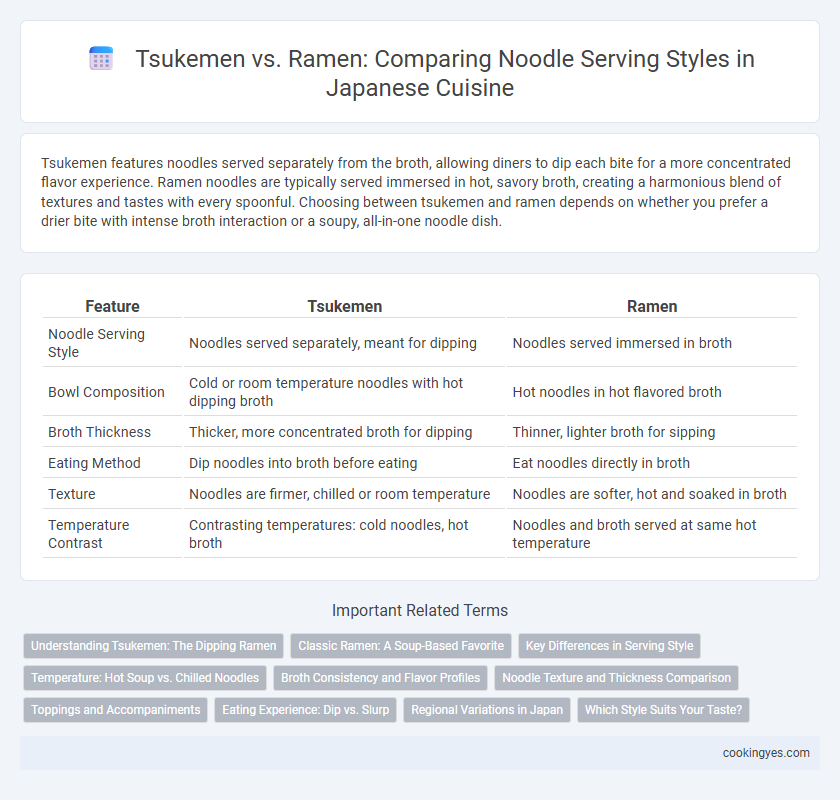Tsukemen features noodles served separately from the broth, allowing diners to dip each bite for a more concentrated flavor experience. Ramen noodles are typically served immersed in hot, savory broth, creating a harmonious blend of textures and tastes with every spoonful. Choosing between tsukemen and ramen depends on whether you prefer a drier bite with intense broth interaction or a soupy, all-in-one noodle dish.
Table of Comparison
| Feature | Tsukemen | Ramen |
|---|---|---|
| Noodle Serving Style | Noodles served separately, meant for dipping | Noodles served immersed in broth |
| Bowl Composition | Cold or room temperature noodles with hot dipping broth | Hot noodles in hot flavored broth |
| Broth Thickness | Thicker, more concentrated broth for dipping | Thinner, lighter broth for sipping |
| Eating Method | Dip noodles into broth before eating | Eat noodles directly in broth |
| Texture | Noodles are firmer, chilled or room temperature | Noodles are softer, hot and soaked in broth |
| Temperature Contrast | Contrasting temperatures: cold noodles, hot broth | Noodles and broth served at same hot temperature |
Understanding Tsukemen: The Dipping Ramen
Tsukemen, known as dipping ramen, features thick, chewy noodles served separately from a rich, concentrated broth, allowing diners to customize each bite's flavor intensity. Unlike traditional ramen, where noodles are immersed in soup, Tsukemen's serving style enhances the texture contrast and preserves noodle firmness. This distinct presentation emphasizes full flavor control, highlighting Tsukemen's appeal to enthusiasts seeking a unique and interactive noodle experience.
Classic Ramen: A Soup-Based Favorite
Classic ramen is characterized by its rich, savory broth that seamlessly infuses the noodles with flavor, creating a harmonious soup-based experience. Tsukemen, by contrast, serves noodles and broth separately, allowing diners to dip the noodles for a more concentrated taste. This traditional soup-based serving style of classic ramen offers a comforting blend of tender noodles and aromatic broth, emphasizing warmth and depth.
Key Differences in Serving Style
Tsukemen features cold noodles served separately from a concentrated dipping broth, allowing diners to control the flavor intensity and temperature with each bite. Ramen, by contrast, is served with hot noodles immersed directly in a seasoned soup, offering a unified, savory experience. The contrasting serving styles create distinct textural and flavor dynamics, with tsukemen emphasizing a more interactive and customizable meal.
Temperature: Hot Soup vs. Chilled Noodles
Tsukemen features chilled noodles served separately from a hot, concentrated dipping broth, enhancing texture contrast and allowing personalized temperature control. Ramen traditionally combines noodles and hot soup in one bowl, delivering a harmonious, warm experience where noodles soak in savory broth. This temperature difference influences the overall eating style, with Tsukemen offering a refreshing yet intense flavor burst, while ramen provides comforting warmth and integrated taste.
Broth Consistency and Flavor Profiles
Tsukemen features noodles served separately from a thick, intensely flavored dipping broth, allowing for a concentrated, savory experience with a rich and often more umami-packed sauce. In contrast, ramen serves noodles immersed in a lighter, aromatic broth that balances the flavors, creating a harmonious blend of savory, salty, and sometimes creamy elements. The broth consistency in tsukemen is notably denser, while ramen broth varies from clear shoyu to creamy tonkotsu, influencing the overall flavor profile and mouthfeel.
Noodle Texture and Thickness Comparison
Tsukemen features thicker, chewier noodles that maintain firmness when dipped in rich, concentrated broth, enhancing a robust texture contrast. In contrast, ramen noodles are thinner and softer, absorbed in a lighter, hot soup that softens their texture for a more delicate mouthfeel. The distinct noodle thickness and texture between tsukemen and ramen cater to different preferences--tsukemen offers a hearty bite, while ramen provides a smooth, slurp-friendly experience.
Toppings and Accompaniments
Tsukemen features cold noodles served separately from a rich, concentrated dipping broth, allowing toppings like bamboo shoots, pork chashu, soft-boiled eggs, and nori to remain distinct and customized by the diner. In contrast, ramen presents noodles submerged in a savory hot broth, integrating toppings such as green onions, menma, narutomaki, and corn directly within the soup for a unified flavor experience. Tsukemen's style emphasizes texture contrast and dipping control, while ramen offers a harmonious blend of ingredients in a single bowl.
Eating Experience: Dip vs. Slurp
Tsukemen offers a unique eating experience by serving cold noodles separately from a rich, concentrated dipping broth, allowing diners to control the flavor intensity with each bite. In contrast, traditional ramen combines noodles and hot broth in one bowl, encouraging a continuous slurping technique that blends flavors seamlessly. The dip style of tsukemen emphasizes texture and temperature contrast, enhancing noodle firmness and savoriness, whereas ramen's slurping maximizes aroma and warmth in every mouthful.
Regional Variations in Japan
Tsukemen, a dipping noodle dish where cooked noodles and broth are served separately, is particularly popular in the Kanto region, especially Tokyo, emphasizing a rich and concentrated dipping sauce for enhanced flavor. In contrast, traditional ramen, with noodles served immersed in hot broth, is widely favored in regions like Hokkaido, known for its miso ramen specialty, and Kyushu, famous for tonkotsu ramen. These regional variations highlight distinct preferences in noodle texture, broth intensity, and serving temperature that define Japanese noodle culture.
Which Style Suits Your Taste?
Tsukemen features cold noodles served separately from a hot, concentrated dipping broth, offering a customizable flavor intensity, while traditional ramen presents noodles immersed in a seasoned soup, providing a harmonious blend of textures and tastes. If you prefer a more interactive dining experience with customizable broth concentration and temperature contrasts, tsukemen might suit your palate. Conversely, ramen is ideal for those who enjoy a consistent, warm, and integrated noodle and broth combination.
Tsukemen vs Ramen for noodle serving style Infographic

 cookingyes.com
cookingyes.com